 Advances in Pure Mathematics, 2011, 1, 163-169 doi:10.4236/apm.2011.14030 Published Online July 2011 (http://www.SciRP.org/journal/apm) Copyright © 2011 SciRes. APM On Some Fixed Point Theorems for 1-Set Weakly Contractive Multi-Valued Mappings with Weakly Sequentially Closed Graph Afif Ben Amar1, Aneta Sikorska-Nowak2 1Département de Mathéma tiques Université de Gafsa Faculté des sciences d e Gafsa Cité Universitaire Zarrou k, Gafsa Tunisie 2Faculty of Mathematics and Computer Science, Adam Mickiewicz University, Poznan, Poland E-mail: afif.benamar@ipeis.rnu.tn, anetas@a mu.edu.pl Received February 20, 2011; revised March 11, 20 1 1; acce pted March 21, 2011 Abstract In this paper we prove Leray-Schauder and Furi-Pera types fixed point theorems for a class of multi-valued mappings with weakly sequentially closed graph. Our results improve and extend previous results for weakly sequentially closed maps and are very important in applications, mainly for the investigating of boundary value problems on noncompact intervals. Keywords: Measures of Weak Noncompactness, Weakly Condensing, Weakly Nonexpansive 1. Introduction bd cv cl,cv :, =: , =: ,, PXAXA is nonemptyandbounded PXAXA isnonemptyandconvex PX XA isnonemptyclosedandconvex Fixed point theory for weakly completely continuous multi-valued mappings takes an important role for the existence of solutions for operator inclusions, positive solutions of elliptic equation with discontinuous non- linearities and periodic and boundary value problems for second order differential inclusions (see [1-3]) and others. In [4] O’Regan has proved a number of fixed point theorems for multi-valued maps defined on bounded domains with weakly compact convex values and which are weakly contractive and have weakly sequentially closed graph. The aim of the present paper is to extend and improve these theorems to the case of weakly condensing and 1-set weakly contractive multi-valued maps with weakly sequentially closed graph. Further- more, we do not assume that they are from a point into weakly compact convex set. We note that the domains of all of the multi-valued maps discussed here are not assumed to be bounded. Our results generalize and extend relevant and recent ones (see [4-10]). The main condition in our results is formulated in terms of axioma t ic measures of w eak noncom- pactness. Now we shall introduce the notation and give preli- minary results which will be need ed in the paper. Let be a Hausdorff linear topological space, then we define Let a non-empty subset of a Banach space Y and be a multi-valued mapping. We denote :2 X FZ ==,: yZ RFFyand GrFzxZXxFz the range and the graph of respectively. Moreover, for every subset of , we put 1=:FAzZFzA and =:AzZFzA . is called upper semicontinuous on Z if 1 A is closed, for every closed subset of (or, equivalently, if A is open, for every open subset of ). is called weakly upper semicontinuous if is upper semicontinuous with respect to the weak topologies of and . Now we suppose that is a Banach space and is weakly closed in . is said to be weakly compact if the set RF is relatively weakly compact in . Moreover, is said 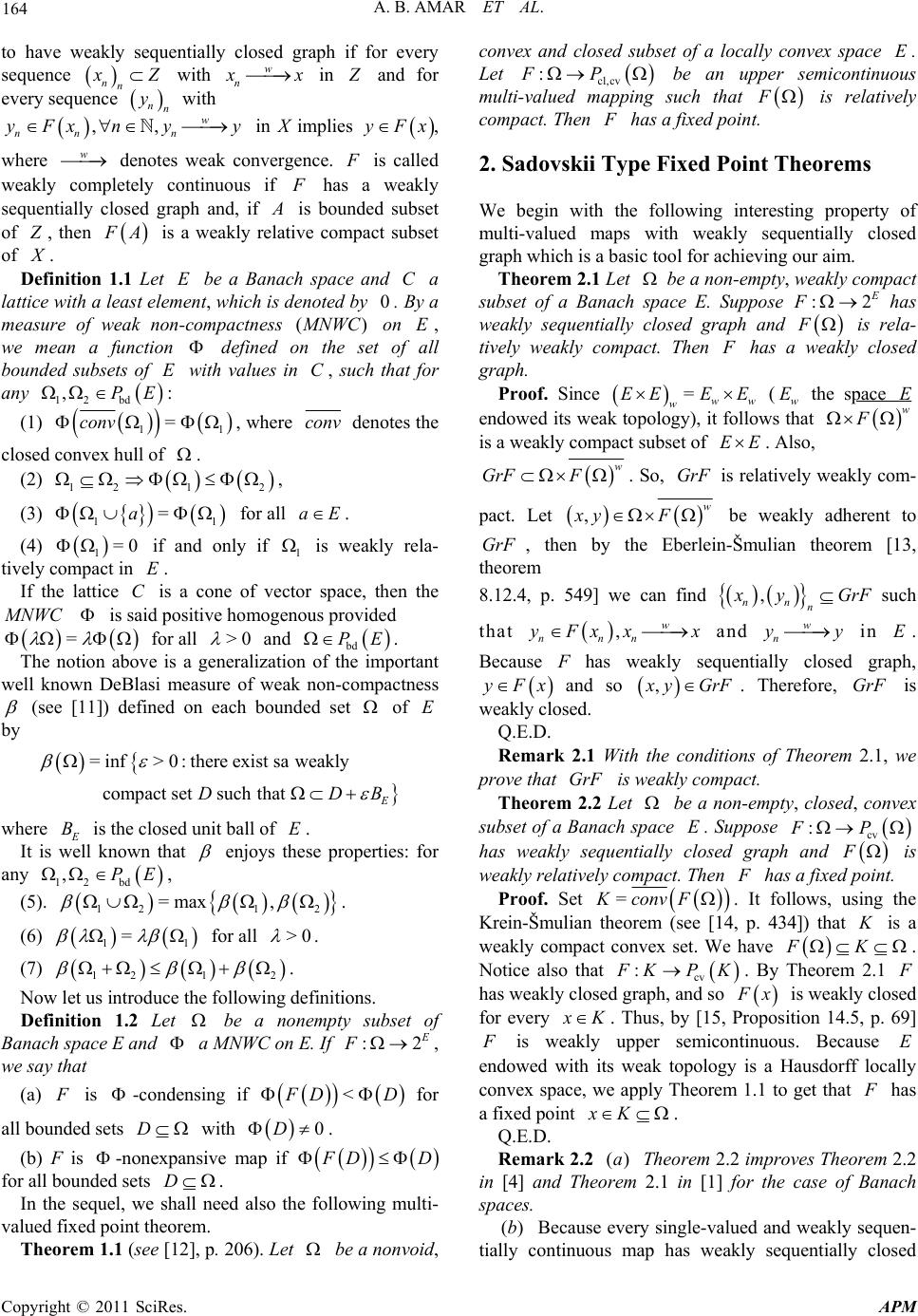 164 A. B. AMAR ET AL. to have weakly sequentially closed graph if for every sequence nn Z with w n x in and for every sequence with nn y ,, n n y nn x w yF y in X implies yFx, where w denotes weak convergence. is called weakly completely continuous if has a weakly sequentially closed graph and, if is bounded subset of , then A is a weakly relative compact subset of . Definition 1.1 Let be a Banach space and a lattice with a least elemen t, which is denoted by . By a measure of weak non-compactness () E C 0 NWC E on , we mean a function defined on the set of all bounded subsets of with values in , such that for any : E bd PE C 12 , (1) 1 = 1 conv , where conv denotes the closed convex hull of . (2) 1 2 aE 1 12 =a =0 E C , (3) for all . 11 (4) 1 if and only if is weakly rela- tively compact in . If the lattice is a cone of vector space, then the NWC is said positive homogenous provided for all = >0 and PE bd The notion above is a generalization of the important well known DeBlasi measure of weak non-compactness . (see [11]) defined on each bounded set of by E weakly = iheret sa s hat nf>0:t compact set exis uch t DDB where B is the closed unit ball of . E It is well known that enjoys these properties: for any , bd PE 12 , (5). 1 2 , 1>0 12 =max 1 = . (6) for all . (7) . 12 1 2 :2 Now let us introduce the following definitions. Definition 1.2 Let be a nonempty subset of Banach space E and a MNWC on E. If F , we say that (a) is -condensing if < DD for all bounded sets with . D D0 (b) F is -nonexpansive map if DD E for all bounded sets . D In the sequel, we shall need also the following multi- valued fixed point theorem. Theorem 1.1 (see [12], p. 206). Let be a nonvoid, convex and closed subset of a locally convex space . Let :FP cl,cv F be an upper semicontinuous multi-valued mapping such that is relatively compact. Then has a fixed point. 2. Sadovskii Type Fixed Point Theorems We begin with the following interesting property of multi-valued maps with weakly sequentially closed graph which is a basic tool for achieving our aim. Theorem 2.1 Let be a non-empty, weakly compact subset of a Banach space E. Suppose :2 F has weakly sequentially closed graph and is rela- tively weakly compact. Then F has a weakly closed graph. =EEEE ww w Proof. Since E (w E the space endowed its weak topology), it follows that w F EE is a weakly compact subset of . Also, w GrF F GrF . So, is relatively weakly com- pact. Let ,w xy F GrF , nn n be weakly adherent to , then by the Eberlein-Šmulian theorem [13, theorem 8.12.4, p. 549] we can find yGrF such that ,w nnn yFxx xw n and y E in . Because F has weakly sequentially closed graph, yFx and so ,yGrFF GrF . Therefore, Gr is weakly closed. Q.E.D. Remark 2.1 With the conditions of Theorem 2.1, we prove that is weakly compact. Theorem 2.2 Let be a non-empty, closed, convex subset of a Banach space . Suppose Ecv :FP has weakly sequentially closed graph and F is weakly relatively compact. Then ha s a fixed poi nt. =KconvF K Proof. Set . It follows, using the Krein-Šmulian theorem (see [14, p. 434]) that is a weakly compact convex set. We have FK . Notice also that cv KPK. By Theorem 2.1 : has weakly closed graph, and so x is weakly closed for every K . Thus, by [15, Proposition 14.5, p. 69] is weakly upper semicontinuous. Because endowed with its weak topology is a Hausdorff locally convex space, we apply Theorem 1.1 to get that E has a fixed point xK ()a ()b . Q.E.D. Remark 2.2 Theorem 2.2 improves Theorem 2.2 in [4] and Theorem 2.1 in [1] for the case of Banach spaces. Because every single-valued and weakly sequen- tially continuous map has weakly sequentially closed Copyright © 2011 SciRes. APM 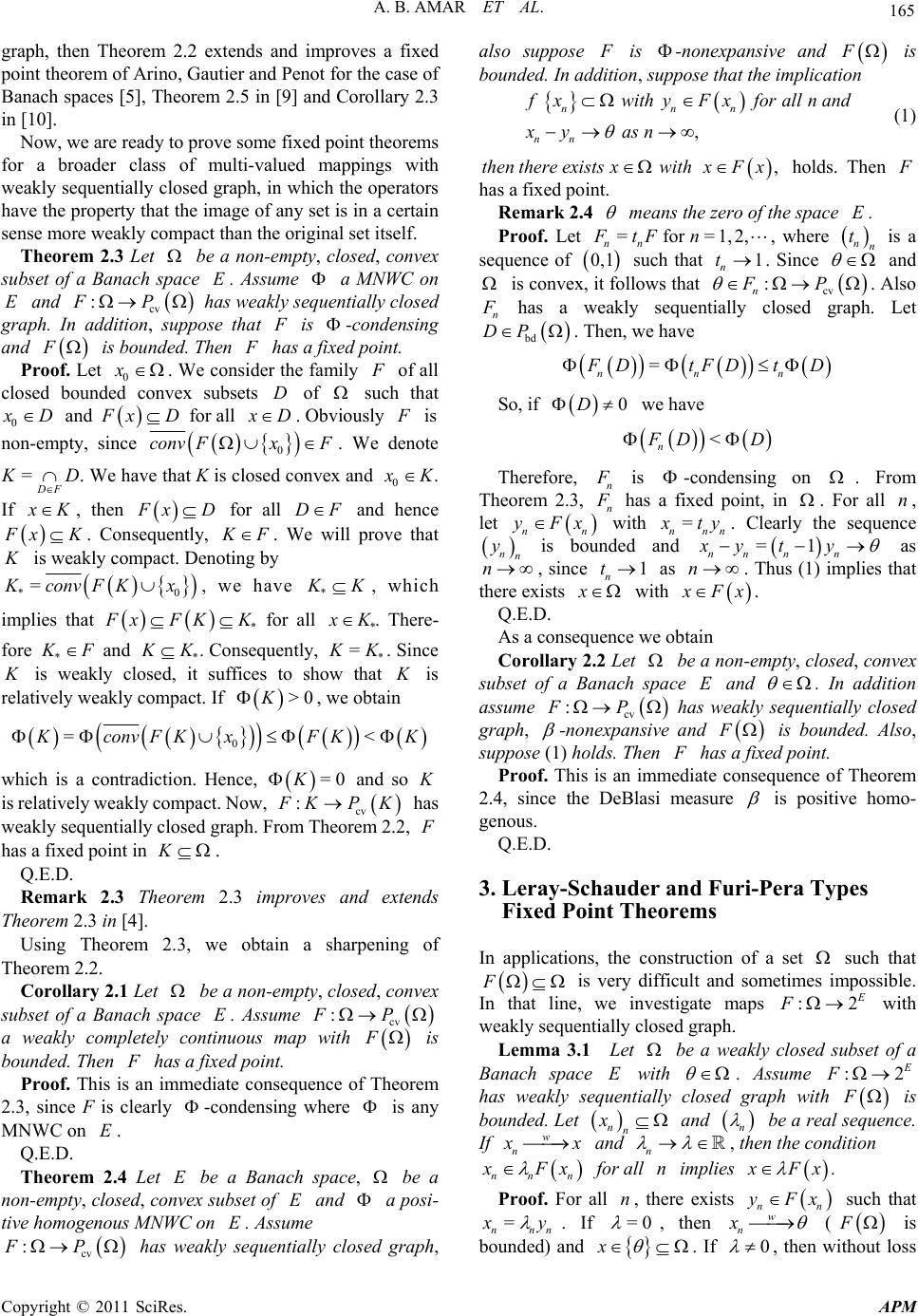 A. B. AMAR ET AL. 165 : F graph, then Theorem 2.2 extends and improves a fixed point theorem of Arino, Gautier and Penot for the case of Banach spaces [5], Theorem 2.5 in [9] and Corollary 2.3 in [10]. is -nonexpansive and Now, we are ready to prove some fixed point theorems for a broader class of multi-valued mappings with weakly sequentially closed graph, in which the operators have the property that the image of any set is in a certain sense more weakly compact than the original set itself. Theorem 2.3 Let be a non-empty, closed, convex subset of a Banach space . Assume a MNWC on and cv has weakly sequentially closed graph. In addition, suppose that E E PF is -condensing and is bounded. Then F has a fixed point. Proof. Let 0. We consider the family x of all closed bounded convex subsets of such that D 0 D and xD for all D. Obviously is non-empty, since 0 con . We denote v FxF =DF D 0 . We have that K is closed convex and K . If K, then xD for all and hence DF xK. Consequently, F . We will prove that is weakly compact. Denoting by *0 = convFKx* , we have K, which implies that * xFKK for all * K. There- fore * and * K= . Consequently, * K. Since is weakly closed, it suffices to show that is relatively weakly compact. If , we obtain K>0 0 = < conv FKxF K K K which is a contradiction. Hence, and so is relatively weakly compact. Now, =0K cv : KPK has weakly sequentially closed graph. Fr om Theorem 2. 2 , has a fixed point in . K Q.E.D. Remark 2.3 Theorem 2.3 improves and extends Theorem 2.3 in [4]. Using Theorem 2.3, we obtain a sharpening of Theorem 2.2. Corolla ry 2 .1 Let be a non-empty, closed, convex subset of a Banach space . Assume E cv FP : a weakly completely continuous map with F is bounded. Then has a fixed point. Proof. This is an immediate consequence of Theorem 2.3, since F is clearly -condensing where is any MNWC on . E Q.E.D. Theorem 2.4 Let be a Banach space, E be a non-empty, closed, convex subset of and a posi- tive homogenous MNWC on . Assume has weakly sequentially closed graph, also suppose is bounded. In addition, suppose that the implication , nnn nn xwithyFxforalln and xy asn ,then thereexistsxwithxFx (1) holds. Then has a fixed point. Remark 2.4 means the zero of the space . E =for=1,2, nn FtF n Proof. Let , where nn t is a sequence of 0,1 1 n such that t. Since and is convex, it follows that :FP n cvn. Also has a weakly sequentially closed graph. Let bd DP. Then, we have = nnn DtFDtD 0D we have So, if < n DD n is Therefore, -condensing on . From Theorem 2.3, n has a fixed point, in . For all , let n nn Fx=nn with n ty. Clearly the sequence nn y =1 nn xy ty is bounded and n n n 1 n tn x as , since as . Thus (1) implies that there exists with Fx. Q.E.D. As a consequence we obtain Corolla ry 2 .2 Let be a non-empty, closed, convex subset of a Banach space and E . In addition assume :FP cv has weakly sequentially closed graph, -nonexpansive and is bounded. Also, suppose (1) holds. Then F has a fixed point. Proof. This is an immediate consequence of Theorem 2.4, since the DeBlasi measure is positive homo- genous. Q.E.D. 3. Leray-Schauder and Furi-Pera Types Fixed Point Theorems In applications, the construction of a set such that F :2 is very difficult and sometimes impossible. In that line, we investigate maps F with weakly sequentially closed graph. Lemma 3.1 Let be a weakly closed subset of a Banach space with E E FP cv : E :2. Assume F has weakly sequentially closed graph with F is bounded. Let x nn and n be a real sequence. If w n , then the condition x n and nn n Fx for all n implies Fx n n . Proof. For all , there exists n Fx = such that nnn w n x yF . If =0 , then ( is bounded) and x 0. If , then without loss Copyright © 2011 SciRes. APM 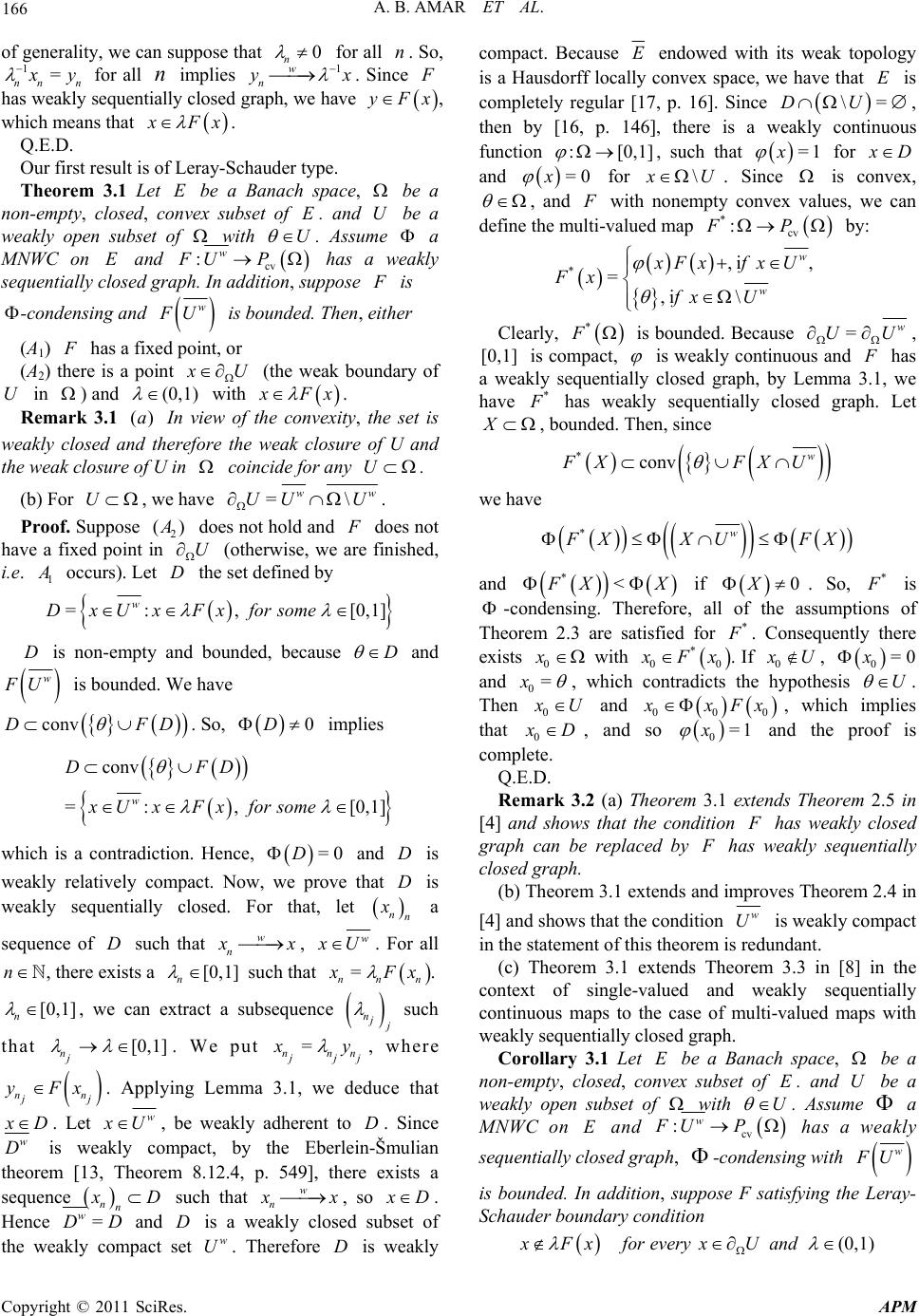 166 0 A. B. AMAR ET AL. of generality, we can suppose that n for all . So, nnn n 1= y 1 for all implies n nw x . Since has weakly sequentially closed graph, we have Fx, which means that Fx E . Q.E.D. Our first result is of Leray-Schauder type. Theorem 3.1 Let be a Banach space, be a non-empty, closed, convex subset of . and be a weakly open subset of with E U U . Assume a MNWC on and E cv has a weakly sequentially closed graph. In addition, suppose :w FU P is -condensing and w U is bounded. Then, either (A1) has a fixed point, or (A2) there is a point U (0,1) (the weak boundary of in ) and U with Fx . Remark 3.1 In view of the convexity, the set is weakly closed and therefore the weak closure of U and the weak closure of U in coincide for any U. ()a (b) For , we have U =\ ww U 2 () UU . Proof. Suppose does not hold and does not have a fixed point in (otherwise, we are finished, i.e. U 1 occurs). Let t he set defi ne d b y D : ,[0,1] w UxFxfome D =Dx D rso is non-empty and bounded, because and w U conv is bo u nded. We have DFD0D. So, implies nv = : ,[0,1] w DF xFxfor me =0D D co xU D so D which is a contradiction. Hence, and is weakly relatively compact. Now, we prove that is weakly sequentially closed. For that, let nn a sequence of such that Dw n x , w U. For all , there exists a n[0,1] n such that = nnn Fx . [0,1] n , we can extract a subsequence nj [0, such that 1] nj . We put = nnn jj y , where nn j yFx. Applying Lemma 3.1, we deduce that D. Let w UD, be weakly adherent to . Since w D is weakly compact, by the Eberlein-Šmulian theorem [13, Theorem 8.12.4, p. 549], there exists a sequence nn D such that w n x , so D . Hence = w DD D and is a weakly closed subset of the weakly compact set . Therefore is weakly compact. Because Dw U EE \=DU : [0,1] endowed with its weak topology is a Hausdorff locally convex space, we have that is completely regular [17, p. 16]. Since , then by [16, p. 146], there is a weakly continuous function =1x , such that for D and =0x \ for U. Since is convex, , and with nonempty convex values, we can define the multi-valued map by: *cv : FP *,i, =,i \ w w xFxfx U Fx fx U * F is bounded. Because Clearly, =w UU [0,1] , is compact, is weakly continuous and has a weakly sequentially closed graph, by Lemma 3.1, we have * has weakly sequentially closed graph. Let , bounded. Then, since *conv w FX FXU we have *w XXUFX *< and XX if 0X * . So, is -condensing. Therefore, all of the assumptions of Theorem 2.3 are satisfied for * . Consequently there exists * 00 with Fx0 . If 0 x U , 0=0x 0=x and U , which contradicts the hypothesis . Then 0 U and 000 xFx , which implies that 0 D , and so and the proof is complete. 0=1x Q.E.D. Remark 3.2 (a) Theorem 3.1 extends Theorem 2.5 in [4] and shows that the condition has weakly closed graph can be replaced by has weakly sequentially closed graph. (b) Theorem 3.1 extends and improves Theorem 2.4 in [4] and shows that the condition w U E is weakly compact in the statement of this theorem is redundant. (c) Theorem 3.1 extends Theorem 3.3 in [8] in the context of single-valued and weakly sequentially continuous maps to the case of multi-valued maps with weakly sequentially closed graph. Corollary 3.1 Let be a Banach space, be a non-empty, closed, convex subset of . and U be a weakly open subset of E with U . Assume a MNWC on and cv :w FU P has a weakly E sequentially closed graph, -condensing with w U is bounded. In addition, suppose F satisfying the Leray- Schauder boundary condition (0,1)xFxfor everyxUand Copyright © 2011 SciRes. APM 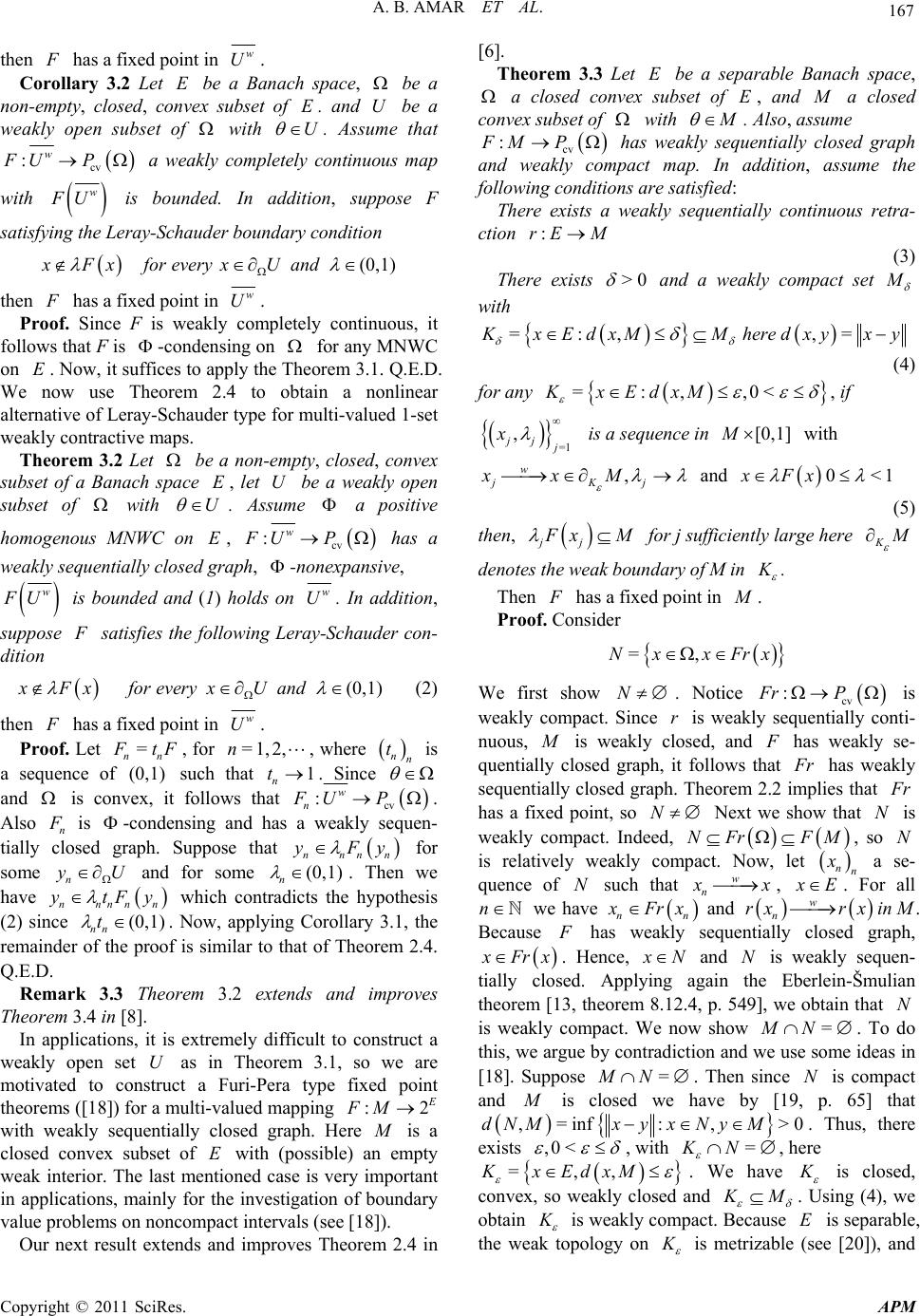 A. B. AMAR ET AL. 167 has a fixed point in w U E then . Corollary 3.2 Let be a Banach space, be a non-empty, closed, convex subset of . and be a weakly open subset of with E U U . Assume that cv wP:FU a weakly completely continuous map with w U (0,1) and is bounded. In addition, suppose F satisfying the Lera y-Schauder boundary condition xFxfor everyxU then has a fixed point in w U U . Proof. Since F is weakly completely continuous, it follows that F is -condensing on for any MNWC on . Now, it suffices to apply the Theorem 3.1. Q.E.D. We now use Theorem 2.4 to obtain a nonlinear alternative of Leray-Schauder type for multi-valued 1-set weakly contractive maps. E Theorem 3.2 Let be a non-empty, closed, convex subset of a Banach space , let be a weakly open subset of with E U . Assume a positive homogenous MNWC on , E cv wP :FU has a weakly sequentially closed graph, -nonexpansive, w U is bounded and (1) holds on w U. In addition, suppose satisfies the following Leray-Schauder con- dition xFxfor everyxU (0,1)and (2) then has a fixed point in w U. Proof. Let = nn tF, for , wh ere =1n,2, nn t is a sequence of such that . Since (0,1) 1 n t and is convex, it follows that wP cv . Also n :FU n is -condensing and has a weakly sequen- tially closed graph. Suppose that nnnn Fy y 1) (0, for some and for some nUn . Then we have nn nnn tF y (0,1) t which contradicts the hypothesis (2) since nn . Now, applying Corollary 3.1, the remainder of the proof is similar to that of Theorem 2.4. Q.E.D. Remark 3.3 Theorem 3.2 extends and improves Theorem 3.4 in [8]. In applications, it is extremely difficult to construct a weakly open set U as in Theorem 3.1, so we are motivated to construct a Furi-Pera type fixed point theorems ([18]) for a multi-valued mapping :2 FM with weakly sequentially closed graph. Here is a closed convex subset of with (possible) an empty weak interior. The last mentioned case is very important in applications, mainly for the investigation of boundary value problems on noncompact intervals (see [18]). E E Our next result extends and improves Theorem 2.4 in [6]. Theorem 3.3 Let be a separable Banach space, a closed convex subset of , and E a closed convex subset of with . Also, assume :FM P :rE M >0 cv has weakly sequentially closed graph and weakly compact map. In addition, assume the following conditions are satisfied: There exists a weakly sequentially continuous retra- ction (3) There exists and a weakly compact set with =:, ,=xEdxMMheredxyx y (4) =:,,0<KxEdxM for any , if =1 , jjj x [0,1]M , w jKj xxM is a seque nce in with 0<1xFx and (5) jj then, xM K for j sufficiently large here denotes the weak boundary of M in . has a fixed point in . Then Proof. Consider =,Nx xFrx N We first show . Notice cv :Fr P r is weakly compact. Since is weakly sequentially conti- nuous, is weakly closed, and has weakly se- quentially closed graph, it follows that r has weakly sequentially closed graph. Theorem 2.2 implies that r N has a fixed point, so N NFr FM N n Next we show that is weakly compact. Indeed, , so is relatively weakly compact. Now, let n a se- quence of such that Nw n x , E n. For all we have nn Fr x and wrxinM n rx . Because has weakly sequentially closed graph, Fr x. Hence, N and is weakly sequen- tially closed. Applying again the Eberlein-Šmulian theorem [13, theorem 8.12.4, p. 549], we obtain that is weakly compact. We now show . To do this, we argue by contradiction and we use some ideas in [18]. Suppose N N =MN = MN N. Then since is compact and is closed we have by [19, p. 65] that ,=inf:,>0dNMx y xNyM ,0< . Thus, there exists , with , here =KN =,,KxEdxM . We have is closed, convex, so weakly closed and M . Using (4), we obtain is weakly compact. Because is separable, the weak topology on E is metrizable (see [20]), and Copyright © 2011 SciRes. APM  168 A. B. AMAR ET AL. let denote this metric. For , let 1,2,i ,<xM i=,UxK i 1, 2, We fix i. Now i U is open in with respect to the topology generated by , and so is weakly open in i U . Also we have ,, wK xMi== ii UU x and ,xMi=, Ki UxK dN ,>M Since , then = w i. Applying Corollary 3.2, we get that there exists NU 0,1 iK y i and i U such that ii Fr y y . In particular, since , then iK i U 1,2,i rsome[0,1] R forM =:ExFr each ii Fr y (6) Now we investigate ,foRx x R is non-empty, because . Also, M RconvF , so by the Krein-Šmulian theorem (see [14, p. 434]), is relatively weakly com- pact. Since F has weakly sequentially closed graph and is compact, we deduce by Lemma 3.1 that [0,1] is weakly sequentially closed. This together with for 1,2,j,=, [0,1] jj yM j implies that we may assume without loss of generality that 00 and \ ww jj yyMK = w K M M Also since ji Fr y we have 000 Fr y . If 0=1 , then 0 0 Fr y [0,1) , which contradicts =MN 0 . Thus, =,= ji . But (5) with 00 = K ryMxyryM implies ji ry M for sufficiently large. This contra- j = dicts (6). Thus . Accordingly, there exists MN M such that = FrxF x ()a* E Q.E.D. Remark 3.4 If is separable and is weakly compact, then there exists a weakly continuous and so weakly sequentially continuous retraction onto (see [21]). ()bE If is reflexive then it suffices to take M is bounded, since a subset of a reflexive Banach space is weakly compact iff it is closed in the weak topology and bounded in the norm topology. Remark 3.5 Theorem 3.3 extends Theorem 2.5 in [7]. ()a ()b As a corollary of Theorem 3.3 we find Theorem 2.6 in [8]. Remark 3.6 If in the statements of Theorem 3.3, the convex set is weakly compact, then a special case of (5) which is useful in applications is If =1 , jjj x [0,1]M , w jj xx is a sequence in with and Fx 0<1 with , then jj xM for j sufficiently large.. (7) Remark 3.7 The set can be with void weak inte- rior. 4. References [1] G. Bonanno and S. A. Marano, “Positive Solutions of Elliptic Equations with Discontinuous Nonlinearities”, Topological Methods in Nonlinear Analysis, Vol. 8, 1996, pp. 263-273. [2] D. Averna and S. A. Marano, “Existence of Solutions for Operator Inclusions: a Unified Approach,” Rendiconti del Seminario Matematico della Universit di Padova, Vol. 102, 1999, pp. 285-303. [3] M. Palmucci and F. Papalini, “Periodic and Boundary Value Problems for Second Order Differential Inclu- sions,” Journal of Applied Mathematics and Stochastic Analysis, Vol. 14, No. 2, 2001, pp. 161-182. doi:10.1155/S1048953301000120 [4] D. O'Regan, “Fixed Point Theorems for Weakly Sequen- tially Closed Maps,” Archivum Mathematicum (Brno) Tomus, Vol. 36, 2000, pp. 61-70. [5] O. Arino, S. Gautier and J. P. Penot, “A Fixed Point Theorem for Sequentially Continuous Mapping with Ap- plication to Ordinary Differential Equations,” Functional Ekvac, Vol. 27, No. 3, 1984, pp. 273-279. [6] D. O'Regan, “Fixed-Point Theory for Weakly Sequen- tially Continuous Mapping,” Mathematical and Com- puter Modelling, Vol. 27, No. 5, 1998, pp. 1-14. [7] D. O'Regan, “A Continuation Method for Weakly Con- densing Operators,” Zeitschrift fr Analysis und ihre An- wendungen, Vol. 15, 1996, pp. 565-578. [8] A. Ben Amar and M. Mnif, “Leray-Schauder Alternatives for Weakly Sequentially Continuous Mappings and Ap- plication to Transport Equation,” Mathematical Methods in The Applied Sciences, Vol. 33, No. 1, 2010, pp. 80-90. [9] A. Ben Amar, A. Jeribi and M. Mnif, “Some Fixed Point Theorems and Application to Biological Model,” Nu- merical Functional Analysis and Optimization, Vol. 29, No. 1, 2008, pp. 1-23. doi:10.1080/01630560701749482. [10] M. A. Taoudi, “Krasnosel’skii Type Fixed Point Theo- rems under Weak Topology Features,” Nonlinear Analy- sis, Vol. 72, No. 1, 2010, pp. 478-482. Copyright © 2011 SciRes. APM 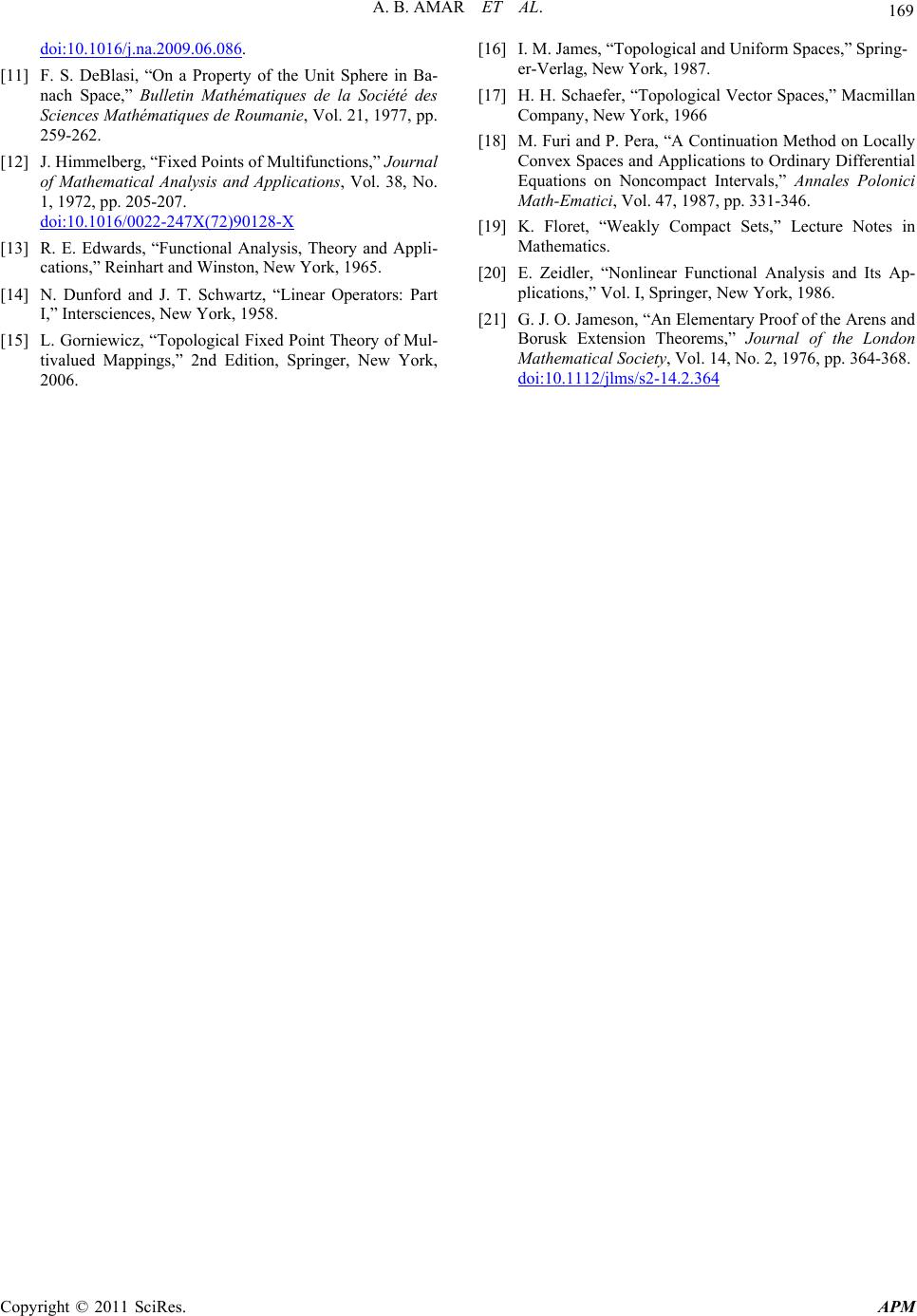 A. B. AMAR ET AL. Copyright © 2011 SciRes. APM 169 doi:10.1016/j.na.2009.06.086. [11] F. S. DeBlasi, “On a Property of the Unit Sphere in Ba- nach Space,” Bulletin Mathématiques de la Société des Sciences Mathématiques de Roumanie, Vol. 21, 1977, pp. 259-262. [12] J. Himmelberg, “Fixed Points of Multifunctions,” Journal of Mathematical Analysis and Applications, Vol. 38, No. 1, 1972, pp. 205-207. doi:10.1016/0022-247X(72)90128-X [13] R. E. Edwards, “Functional Analysis, Theory and Appli- cations,” Reinhart and Winston, New York, 1965. [14] N. Dunford and J. T. Schwartz, “Linear Operators: Part I,” Intersciences, New York, 1958. [15] L. Gorniewicz, “Topological Fixed Point Theory of Mul- tivalued Mappings,” 2nd Edition, Springer, New York, 2006. [16] I. M. James, “Topological and Uniform Spaces,” Spring- er-Verlag, New York, 1987. [17] H. H. Schaefer, “Topological Vector Spaces,” Macmillan Company, New York, 1966 [18] M. Furi and P. Pera, “A Continuation Method on Locally Convex Spaces and Applications to Ordinary Differential Equations on Noncompact Intervals,” Annales Polonici Math-Ematici, Vol. 47, 1987, pp. 331-346. [19] K. Floret, “Weakly Compact Sets,” Lecture Notes in Mathematics. [20] E. Zeidler, “Nonlinear Functional Analysis and Its Ap- plications,” Vol. I, Springer, New York, 1986. [21] G. J. O. Jameson, “An Eleme ntary Proof of the Arens and Borusk Extension Theorems,” Journal of the London Mathematical Society, Vol. 14, No. 2, 1976, pp. 364-368. doi:10.1112/jlms/s2-14.2.364
|